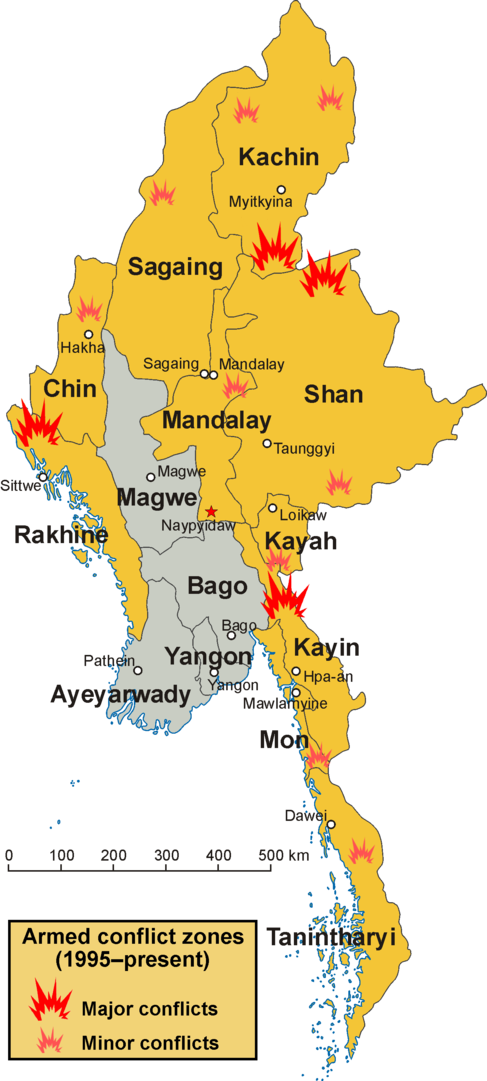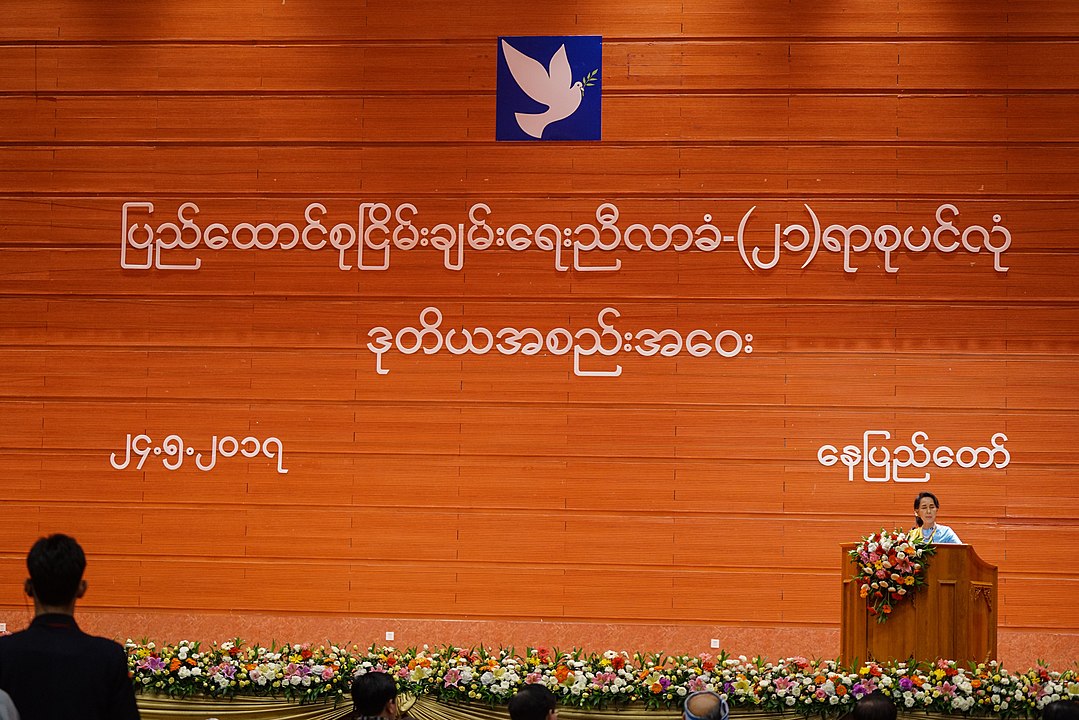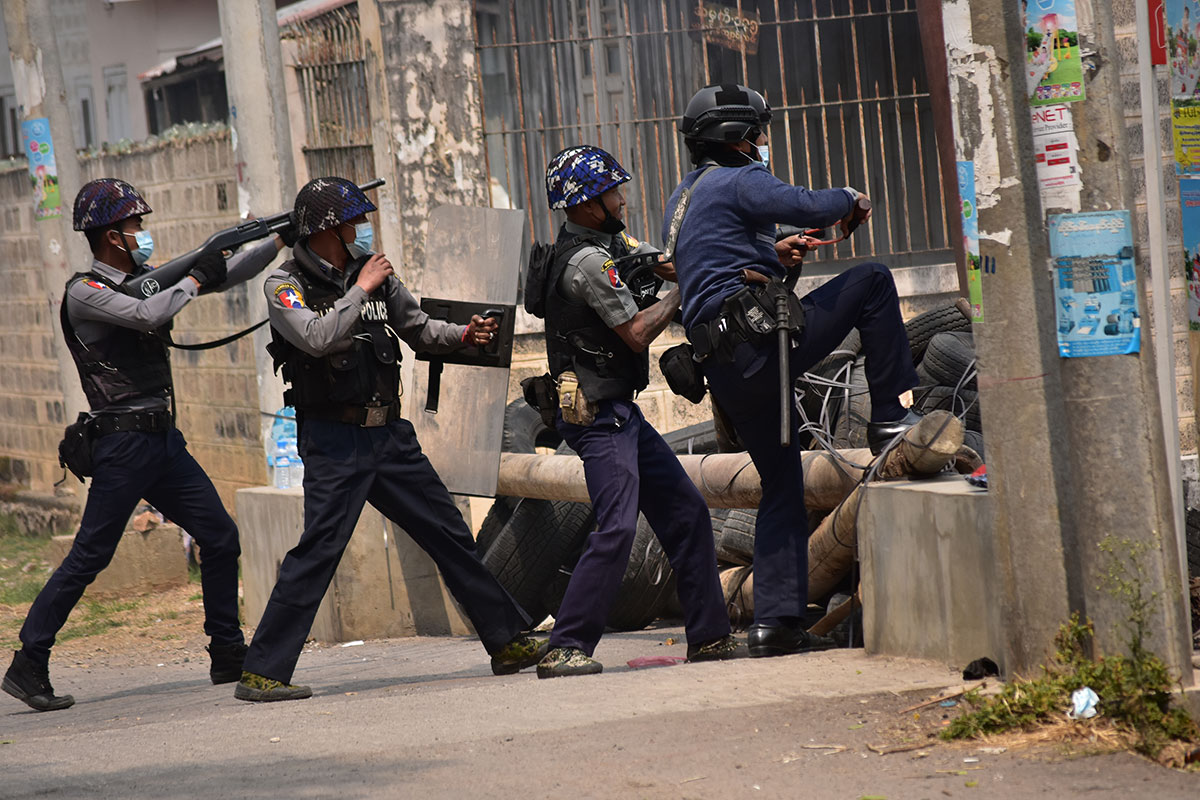
Myanmar’s history from 1957 to 2010 was marked by ongoing armed conflict between the military (known locally as the Tatmadaw) and a variety of ethnic armed organizations (EAOs). Although the Tatmadaw reached occasional ceasefires with some groups during that period, the transition initiated in 2010 included an explicit objective to achieve a more comprehensive peace agreement. The Nationwide Ceasefire Agreement (NCA), initiated by the military-aligned Union Solidarity and Development Party (USDP) government that took power in 2011, was to be the instrument for that change. This article examines the evolution of the peace process, from the new approaches to ceasefire negotiations used by the USPD, to the increased bureaucratization of political negotiations under the National League for Democracy (NLD) government (2016-2021). It then considers how the February 2021 coup has impacted the positions, perceptions, and relations of stakeholders in the peace process. These considerations lead to the unfortunate conclusion that while all sides have the impression that they are “winning”, peace negotiations are unlikely to resume. Moreover, even when talks resume, the NCA may no longer be a viable vehicle for attaining peace.
Centralization of a country without a social pact
Myanmar is home to a large diversity of ethnic groups, speaking languages of Burmese, Sino-Tibetan, Thai, Mon, and Sanskrit origins, among others. Under British colonial rule, the mountainous border areas were controlled through a series of loose arrangements with local ethnic rulers, while the Burmese heartland was ruled directly.
In 1947, a loose alliance was created between the Bamar majority and the leaders of the Kachin, Shan, and Chin to rid Burma of its colonial masters. However, a provision of this agreement that called for a referendum on the creation of a federal state after ten years was never implemented. In 1962 the Tatmadaw seized power and ruled Myanmar until the initiation of political, economic, and peace transitions in 2010, after which it retained influence via an ad hoc power sharing arrangement with the civilian governments.
The period from 1957 to 2010 was marked by widespread armed ethnic resistance to military rule, the main aims of which were to achieve self-governance or independence for the ethnic minorities, and expelling the Tatmadaw from ethnic areas. Although some of the EAOs were formed around ideological convictions, most cannot be said to have a “Weltbild” that guides their political thinking.
Throughout its rule, the Tatmadaw undertook ceasefire discussions with various armed groups in an attempt to pacify them. The record of these is mixed, with some lasting for decades (for instance in Mon, Chin, Wa states), while others (such as in Kachin State) were more precarious and saw repeated fighting. These ceasefires were simple gentlemen’s agreements. They did not entail further negotiations on changing the political system to mitigate the grievances that fueled the conflicts. There was also no discussion of national identity and notions of inclusion for ethnic minorities, leaving in place the symbolic centrality of the ethnic majority Bamar. Simultaneously, ethnic groups saw the (perceived and real) policy of “Burmanisation” as an existential threat to the identities that they were fighting hard to preserve.

Phase one of the peace process (2010-2015)
Following the initiation of political opening in 2010, the military-aligned USPD was elected into power as the first quasi-civilian government since 1962. Among the many reforms it pursued was a renewed attempt to pacify the ethnic areas. It approached this in fundamentally new ways: while previous talks were usually ad hoc and held between individual local Tatmadaw commanders and EAOs, the new negotiations were led by ministerial level personnel and significantly more coordinated.
The government’s main negotiator (U Aung Min, a former Lieutenant General) made it known that he was willing to meet any armed group without preconditions, as long as they were willing to meet in good faith. To show his good will and assist with negotiations, he established the Myanmar Peace Center (MPC), which was staffed by civilian advisors, including many Burmese who had returned from abroad. These advisors were able to engage with international experts and donors more easily than the General himself. He encouraged these contacts and was open to advice, although he maintained that this was a Myanmar process to be led by Myanmar people. He also made a deliberate effort to engage with advisors to the EAOs, as a way to demonstrate that the process could be trusted.
The General was given a broad mandate for negotiations and had direct access to the President when decisions beyond his remit needed to be taken. The President in turn was able to negotiate directly with the Commander in Chief to secure his support.
The negotiation efforts culminated in a Nationwide Ceasefire Agreement (NCA). Although 13 EAOs participated in the negotiations, only eight (representing 30% of the arms bearers) signed it on 15 October 2015. Of the others, some groups were excluded from signing by the army, and others – mainly along the Chinese border – were pressured not to sign.
The NCA contains several firsts: it is a written agreement; it is a multilateral agreement, intended to be between the army and all EAO (supplemented by the previously agreed bilateral ceasefires); it was signed by six international witnesses (China, India, Thailand, Japan, UN, EU); it contains formal ceasefire monitoring mechanisms; and it lays the ground-work for political dialogue with the clear aim of creating a “federal democratic union”, thus paving the way for constitutional change. The first Union-level Peace Conference took place in February 2016, just before the NLD assumed government following its landslide 2015 election victory.

Phase two of the peace process: increased bureaucratization of negotiations (2016-2020)
The NLD government was viewed by many as a triumph of democratization. There were, however, concerns that the prioritization of political turnover could have a negative effect on peace negotiations. These concerns proved valid, although not in the manner that anyone expected.
The new government completely changed the negotiation structure. The MPC was dismantled and replaced by a National Reconciliation and Peace Centre, staffed entirely by government civil servants. The previous government’s negotiators and advisors were dismissed and a new chief negotiator, Dr. Tin Myo Win, who had little prior experience with the peace process or the ethnic groups, was appointed. This meant that the government’s negotiating team had no institutional memory or understanding of what had been previously negotiated (or how), unlike their counterparts from army and the EAOs (who retained their experienced negotiation teams).
The NLD’s new negotiator had no power to take decisions on his own. Although he had direct access to the de facto head of government Aung San Suu Kyi, her office (characterized by its own trust deficits and power struggles) became a bottleneck for decisions. With its combination of old-guard technocrats and inexperienced NLD cadres, it underestimated the fundamental grievances of the EAOs and their lack of trust in the “Bamar” government, even if it was a democratically elected one. Furthermore, the NLD lost precious time and trust before understanding that an extra-parliamentary process was not a threat to its own parliamentary hegemony.
The growing split and lingering distrust between the NLD government and the Tatmadaw resulted in contradictory messaging and a downward spiral in the effectiveness of the political dialogue. The NLD government’s attempt to separate itself from so-called “military issues” and take the lead in “political things” had the effect of sidelining it in the peace process. Rather than reclaiming space for civilian oversight, it ended up allowing the Tatmadaw considerable autonomy. In what was perceived by many as an attempt to “outdo” the Tatmadaw, the NLD-led negotiation team prioritized accession to the NCA by the earlier non-signatories over setting up a credible political process.
After four years of strenuous efforts, two small EAOs acceded to the NCA. Meanwhile, the political negotiations had produced few tangible results, partly due to the format of the Panglong Conferences (attended by over 800 participants), which were not conducive to decisive negotiation or decision-making. Instead, the peace process had been largely reduced to vague discussions on federalism and disarmament, demobilization, and reintegration (DDR). This lack of results put the signatory EAO leadership under immense pressure and contributed to their increasing disenchantment with the NLD-led process. The EAOs felt that there was no commitment from the government or the Tatmadaw to creating a decentralized federal union, which they saw as the only guarantee against “Bamar encroachment and Tatmadaw occupation”.

A return to armed anarchy (since February 2021)
At the time of writing, it is too early to predict how the coup will affect the peace talks. However, it is clear that in EAO perceptions, the Tatmadaw has moved from being a potential source of solutions to public enemy number one. The coup may have come as a surprise, but it confirmed the suspicions of all the EAOs that the Tatmadaw cannot be trusted and reinforced the belief that it was never sincere; not about dialogue, nor about peace, let alone about political change.
The EAOs have all committed to protecting people that seek shelter in their areas from Tatmadaw persecution. They have also been willing to train some of the urban youth in “self-defense”, but (unlike in 1988) have not incorporated these new volunteers into their own ranks.
The signatory EAOs were quick to pledge their support to the pro-democracy movement and resistance to the coup. While paying lip-service to their NCA commitments, they have been reluctant to engage in political talks with the Tatmadaw. An initiative spearheaded by the signatory coordinating structure that called for inclusive talks with all stakeholders under the auspices of the NCA Witnesses was still-born, due to the Tatmadaw’s refusal to allow outside mediation as well as dissent among the signatory EAOs. Moreover, the varied reactions by different EAOs more generally (ranging from cooperation with the pro-democracy National Unity Government (NUG) to participation in the military-led State Administrative Council) have rendered the coordinating structure non-functional.
For the non-signatory EAOs, the coup has confirmed the invalidity of the NCA. They have all put off talks with the Tatmadaw and more intense fighting has resumed in Kachin, northern Shan, and Kayah States.
The NUG’s call for groups to bear arms in self-defense has created a host of new armed entities under the banner of the People’s Defense Forces (PDFs). The NUG is trying to gather existing EAOs as well as these emerging entities to create a “Federal Union Army”. This initiative has been met with skepticism by most of the EAOs, and is still lacking clear command and control structures. Time will tell how it develops.
Looking Forward: A new process must emerge, but the time is not yet ripe
Before the coup, belief in the NCA as the way forward was waning, and recent events have hastened this process. Even if the Tatmadaw was willing to envisage a ceasefire process, let alone an inclusive political transition, the NCA may no longer be a viable vehicle towards those ends.
The advent of new armed actors in the form of the numerous and increasingly aggressive PDFs (particularly in Kayah, Sagaing, and Magway) further complicates the situation. Moreover, although the coup has had the effect of uniting different entities against the Tatmadaw, the past decade has shown that the existence of a common enemy does not necessarily translate into unity. The complexity of the actors in Myanmar and the extremely low levels of trust among them mean that a process without external facilitation is unlikely to be successful.
For the moment, all sides have the impression that they are “winning” and are thus unwilling to enter any kind of negotiations. However, Myanmar’s history has also shown that there is sometimes little difference between ensuring that the other side does not win and a slow war of attrition in which all lose. This, for now, seems to be the most likely scenario until one or several sides realize that dialogue is the only way forward.
Claudine Haenni
Director, Bridging-Changes
Thailand
